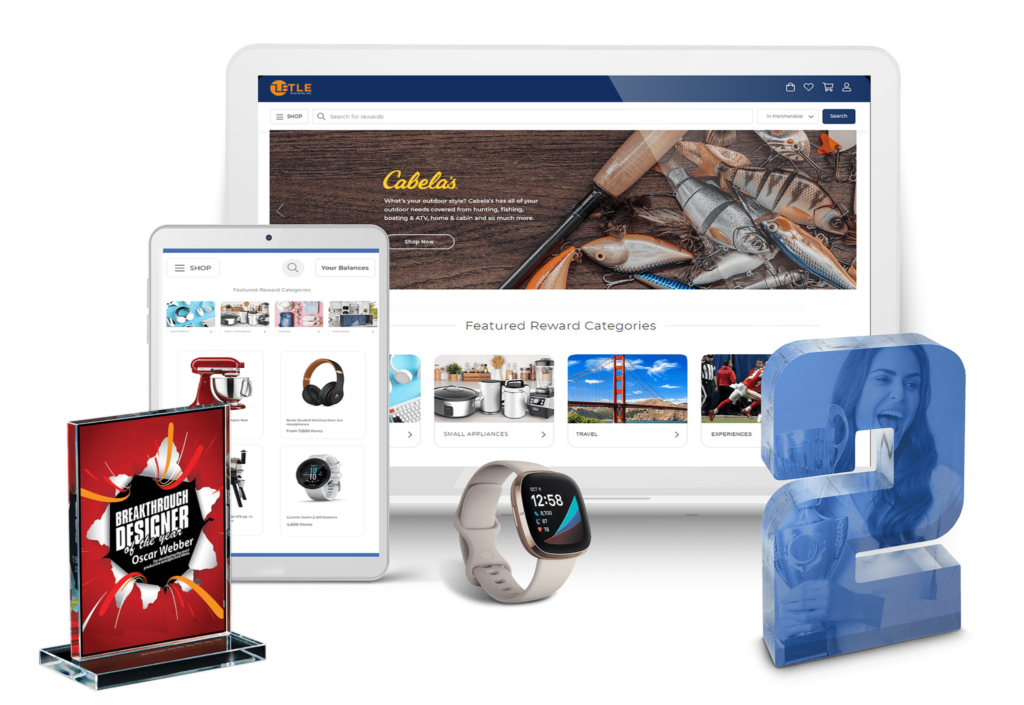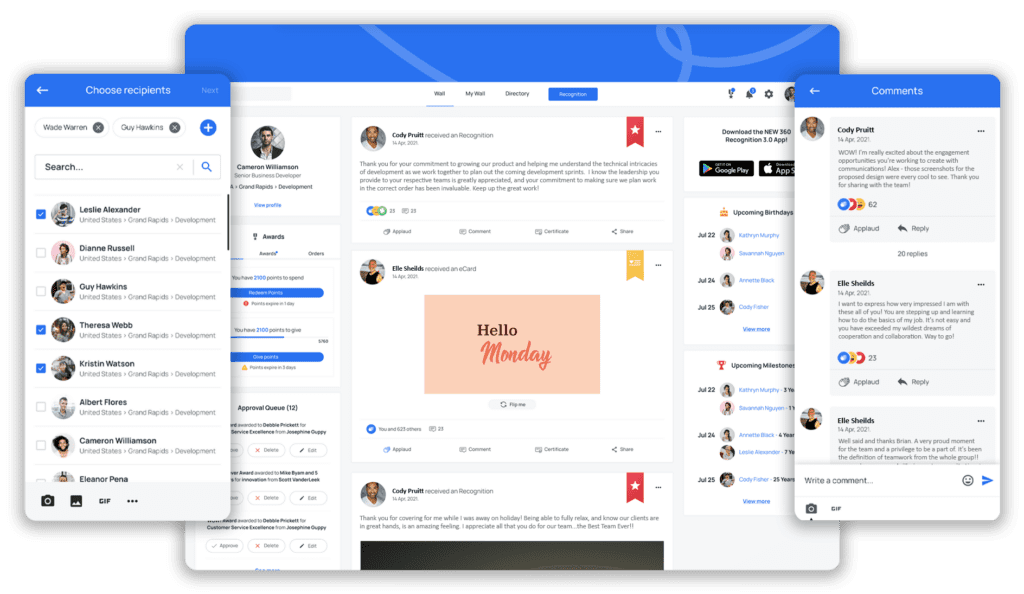October 31, 2023

It’s widely accepted today that employee recognition works. In fact, it’s oftentimes considered one of the most critical factors for improving employee engagement, retention, and morale.
But what may not be so accepted is just how much to budget for these employee recognition initiatives.
While many companies have the best intentions by starting employee recognition programs, the problem lies with not knowing how to effectively plan and execute recognition initiatives.
Too little time and money dedicated to recognition and these programs don’t deliver the desired results. Too much money dedicated to recognition and you may have to answer to your CFO.
To help you determine what your employee recognition budget should be, we’ve explained a few best practices below.
Benefits of Employee Recognition Programs
Employee recognition is a crucial aspect of maintaining a positive and productive work environment. It involves acknowledging and appreciating the efforts and contributions of employees.
The benefits of employee recognition are numerous, including:
- Increased motivation: Recognizing and appreciating employees for their hard work and achievements can boost their motivation and job satisfaction. This, in turn, can lead to increased productivity and better job performance.
- Improved morale: 82% of people are happier when they’re recognized at work. This can create a more positive and harmonious workplace.
- Enhanced employee engagement: When employees believe they’ll be recognized for their work, they’re 7 times more likely to be highly engaged. Recognition can foster employee engagement by making employees feel that their contributions are meaningful and appreciated.
- Higher employee retention rates: Companies with an effective recognition program have 31% lower voluntary turnover. High employee turnover can be costly and disruptive, so recognition can contribute to lower turnover rates and higher employee retention.
- Increased loyalty: Recognizing employees can lead to a sense of loyalty and commitment to the organization. Loyal employees are more likely to go the extra mile, contribute innovative ideas, and act as brand ambassadors.
- Better teamwork: Recognition can foster a sense of camaraderie and teamwork among employees. When individuals are recognized for their contributions, it can encourage collaboration and cooperation among team members.
- Enhanced job satisfaction: Employees who receive recognition tend to be more satisfied with their jobs, which can have a positive impact on their overall well-being and work-life balance.

- Boosted self-esteem and confidence: Recognition can boost an employee's self-esteem and confidence, making them more willing to take on new challenges and responsibilities.
- Increased creativity and innovation: Recognized employees may be more inclined to come up with creative solutions and innovative ideas, as they feel their contributions are valued and encouraged.
- Improved customer service: When employees are recognized and feel valued, they are more likely to provide excellent customer service, which can lead to higher customer satisfaction and loyalty.
- Greater employee loyalty and advocacy: Employees who feel appreciated are more likely to speak positively about their organization to others, helping with recruitment efforts and building a positive employer brand.
- Reduced absenteeism and tardiness: Happy and recognized employees are less likely to take unnecessary sick days or arrive late to work, leading to improved attendance.
- Better overall performance: Recognition programs can drive better individual and team performance, leading to improved business results and profitability.
- Alignment with company values: An employee recognition program can reinforce desired behaviors and values within the organization, helping to create a strong and consistent corporate culture.
- Talent attraction: Companies with a strong culture of recognition are often more attractive to top talent, making it easier to recruit and retain skilled employees.
It's important to note that employee recognition should be genuine, consistent, and tailored to individual preferences and achievements to be most effective. Different employees may respond to various forms of recognition, such as verbal praise, monetary rewards, promotions, or other forms of acknowledgment.
RELATED: Why Employee Recognition Software is Good for Your Business

Setting an Employee Recognition Budget
Setting an employee recognition program budget can be a bit of an art as well as a science. It may take some trial and error to figure out which budget structure works best for your organization.
But many companies already have some kind of budget in place for company lunches, parties, and other events. This can be a great place to start.
What to Include in Your Recognition Budget
Keep in mind that a hefty budget isn’t the most important aspect of an effective employee recognition program. It’s more important that your program be holistic, genuine, and is built into the culture of your company.
That being said, it's likely you'll want to set aside some money for your program. Depending on which type of recognition you'd like to implement, your budget will need to reflect accordingly.
Here are a few types of recognition structures to consider when building your recognition program budget:
Service Milestones and Awards
One of the most prevalent forms of employee recognition programs centers around employee service awards. Traditionally, this has been the primary means of acknowledging employee contributions.
In some companies, the terms "milestone" and "service" are used interchangeably. In contrast, others distinguish service awards as honors given to employees after a specific number of years of service with the company. This could be at the one-year, five-year, ten-year, and so forth marks.
Milestone awards, on the other hand, are more versatile and are granted when an employee achieves a particular milestone.
This milestone might be reaching a specific sales target, successfully completing a designated training program, or achieving a significant tenure with the company. In this sense, a milestone award could also be seen as a form of service award.
These accolades are sometimes presented in the form of personalized items such as plaques or jewelry. However, there is a growing trend in offering choice-based awards. This allows employees to select their rewards from an online catalog.
This route can range greatly in cost, but most companies will choose to allocate a budget per employee per year for these types of awards.

Peer Recognition and Social Acknowledgment
Peer recognition, often referred to as social recognition, involves employees acknowledging each other's efforts. This recognition can take place in private, public settings, or through dedicated social recognition platforms.
Social recognition platforms are designed with peer-to-peer recognition in mind, although most of them permit everyone in the company to recognize each other.
These platforms essentially function as internal social media networks for your organization, enabling people to post on each other's "walls" privately or publicly, offer points, leave comments, and react to achievements.
Social platforms can be more costly upfront, but then decrease in cost over time.

Performance and Incentive Awards
Employee incentive programs serve as a means to motivate employees to achieve specific objectives. These incentives typically come in various forms, including:
- Sales Incentives: Sales incentives are rewards offered to sales teams or individuals to drive them toward achieving sales goals.
- Performance Incentives: Performance incentives are broader and extend to teams outside of sales, such as the Marketing team receiving recognition for achieving record-high organic web traffic.
- Safety Incentives: Safety incentives are geared toward motivating employees in high-risk roles to adhere to necessary safety precautions and minimize workplace incidents.
Rewards for achieving these goals could be a monetary bonus, a custom award, extra PTO, or anything your teams finds valuable.
Recognition Budget as Percentage of Payroll
A popular way to establish an employee recognition budget is by percentage of payroll. This means taking the total amount spent on payroll and finding a percentage of that number to be your recognition budget.
This can be a good option because it ensures your budget stays consistent with certain variables, like raising salaries or company growth.
But what should the percentage be? While some organizations spend as much as 10% of payroll on recognition, this much is oftentimes not needed.
According to research from SHRM, HR professionals are more likely to rate their recognition program as excellent when at least 1% of payroll has been invested.
Simply put, most organizations can see results from their recognition program with a budget of 1 to 2% of payroll, with the average cost of employee recognition programs being 2% of payroll. Just be sure to monitor and adjust accordingly.

Recognition Budget Per Employee
Another great budgeting option is to calculate based on headcount. With this method, you’ll start by estimating how much you’d like to spend on each employee in the year.
From there, you’d simply multiply that amount by the number of employees you have.
According to Recognition Professionals International, the average budget for employee recognition per employee is $30-$50. High-performing companies can average up to $150 per employee (not including service awards).
Getting Started
Providing meaningful recognition is essential for companies to succeed. But finding ways to do so can be increasingly difficult in today’s hybrid workforce. Employee recognition software is a great place to start.
If you’re interested in learning more about Terryberry’s employee recognition platform, contact us today to set up a demo. See how our 360 platform incorporates social recognition, performance awards, milestone awards, and barrier-free communication all under one streamlined platform.

